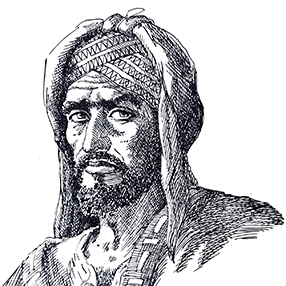from “The Ode of Ímr el Káis”
translated from the Arabic by Lady Anne Blunt and Wilfrid Scawen Blunt
Friend, thou seest the lightning. Mark where it wavereth,
gleameth like fingers twisted, clasped in the cloud-rivers.
Like a lamp new-lighted, so is the flash of it,
trimmed by a hermit nightly pouring oil-sésame.
Stood I long a watcher, twin-friends how dear with me,
till in Othéyb it faded, ended in Dáriji.
By its path we judged it: rain over Káttan is;
far in Sitár it falleth, streameth in Yáthboli.
Gathereth gross the flood-head dammed in Kutéyfati.
Woe to the trees, the branched ones! Woe the kanáhboli!
El Kanáan hath known it, quailed from the lash of it.
Down from their lairs it driveth hot-foot the ibexes.
Known it too hath Téyma; standeth no palm of her
there, nor no house low-founded,—none but her rock-buildings.
Stricken stood Thabíra whelmed by the rush of it,
like an old chief robe-folded, bowed in his striped mantle.
Nay, but he Mujéymir, tall-peaked at dawn of day,
showed like a spinster’s distaff tossed on the flood-water.
Cloud-wrecked lay the valley piled with the load of it,
high as in sacks the Yemámi heapeth his corn-measures.
Seemed it then the song-birds, wine-drunk at sun-rising,
loud through the valley shouted, maddened with spiceries,
While the wild beast corpses, grouped like great bulbs up-torn
cumbered the hollow places, drowned in the night-trouble.
This poem is in the public domain. Published in Poem-a-Day on April 9, 2023, by the Academy of American Poets.
“The Ode of Ímr el Káis” was translated into literal English by Lady Anne Blunt and rendered into English verse by her husband, Wilfrid Scawen Blunt, in The Seven Golden Odes of Pagan Arabia, Also Known as the Moallakat (Self-published, 1903). The original Arabic version of the poem was likely written sometime in the mid-sixth century, during the life of Imruʾ al-Qais, and was later collected into the Muʻallaqāt, known in English as the “Suspended Odes,” a historic anthology of early Arabic poetry. In their note on al-Qais’s ode, the two translators write, “The metre [sic] of Imr el Kais’ Ode is what is known as the ‘long measure,’ each couplet ending in a double dactyl and the terminal syllable li. It is held by Oriental scholars to have been the original model to which all the rest of the Odes more or less closely conformed, and to have founded a new school of verse hitherto unknown in Arabian poetry. Of the whole seven it is the one which has the most of human and natural interest, the least of political invective. It is also the easiest to understand. Apart from the sudden transitions from one subject to another, which are common to them all, there is little that is confusing, or incomprehensible. [. . .] The poem ends with the picture of a sudden storm among the hills, a passage which has been rightly judged to be the highest level of poetry reached by the desert singers. It is the earliest and the simplest of the seven Odes, and constructed with the least of conscious art.”

